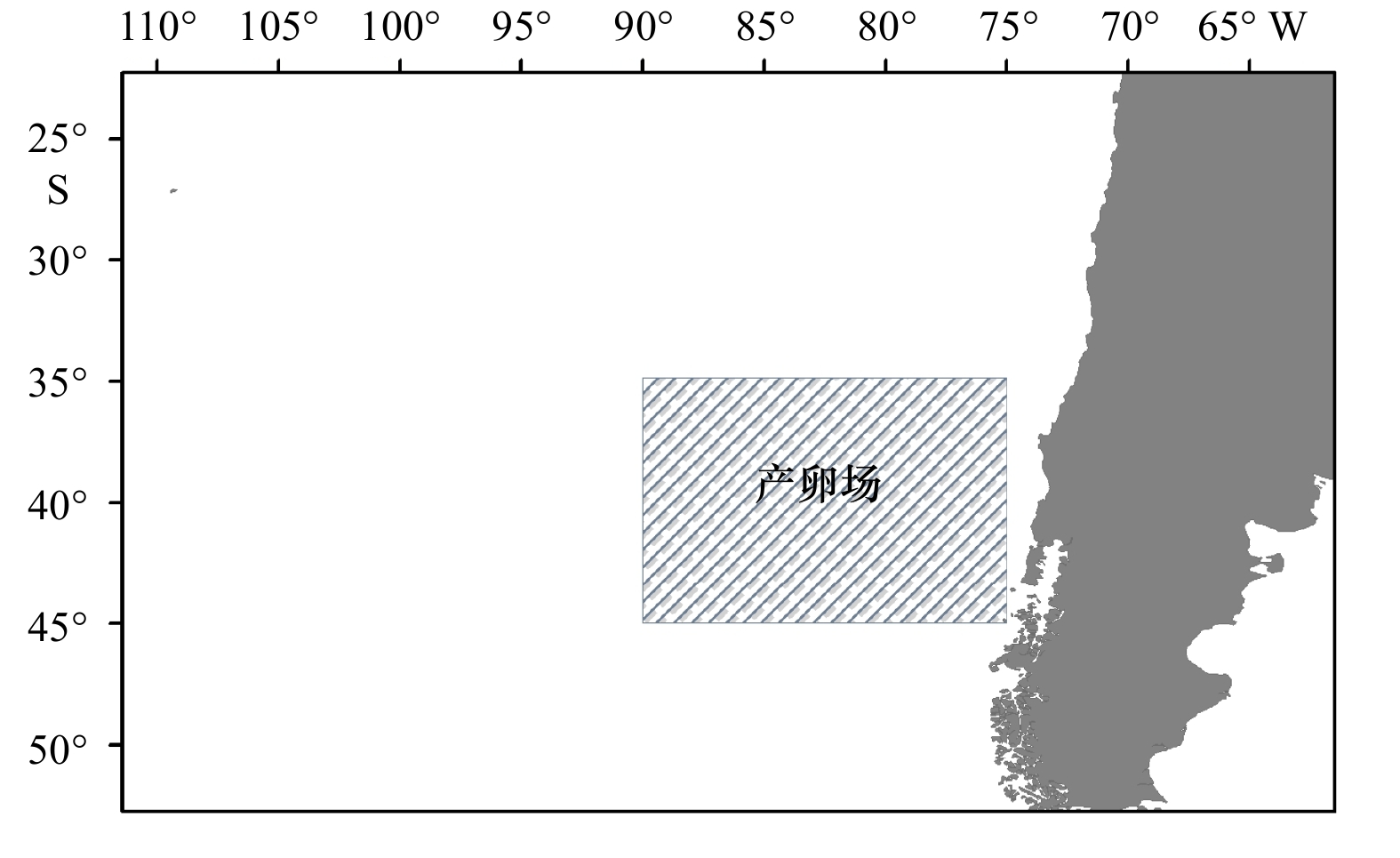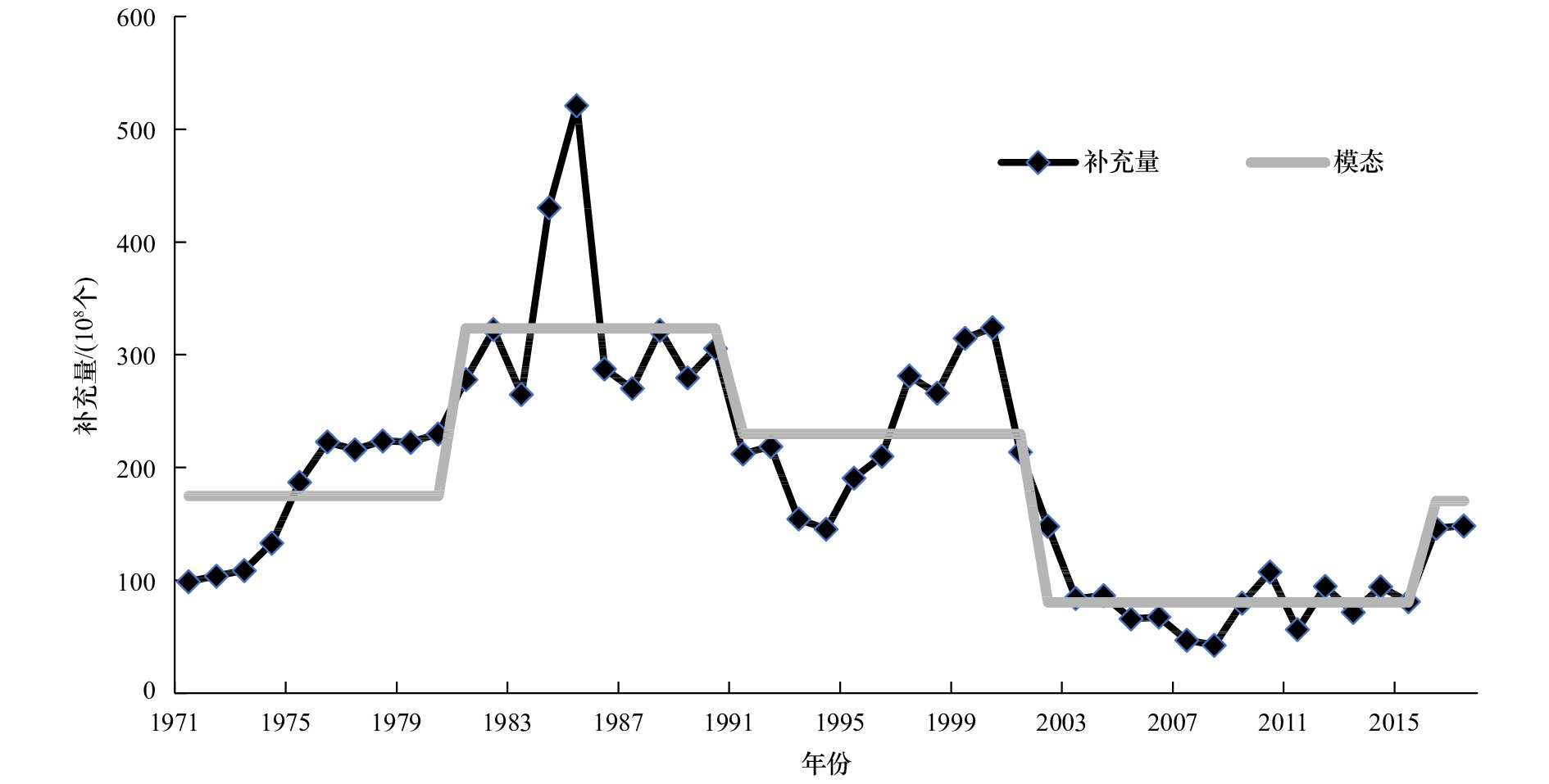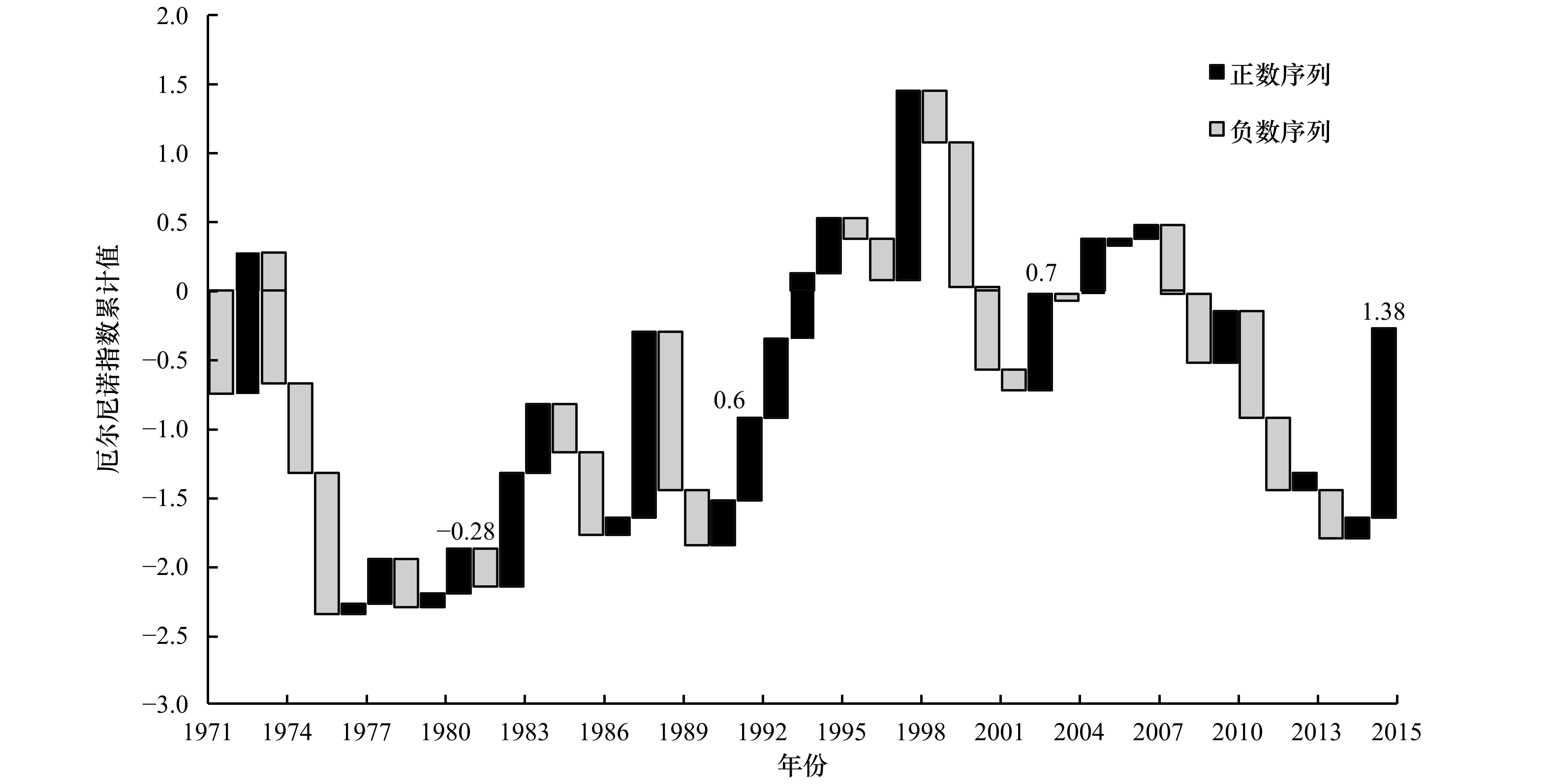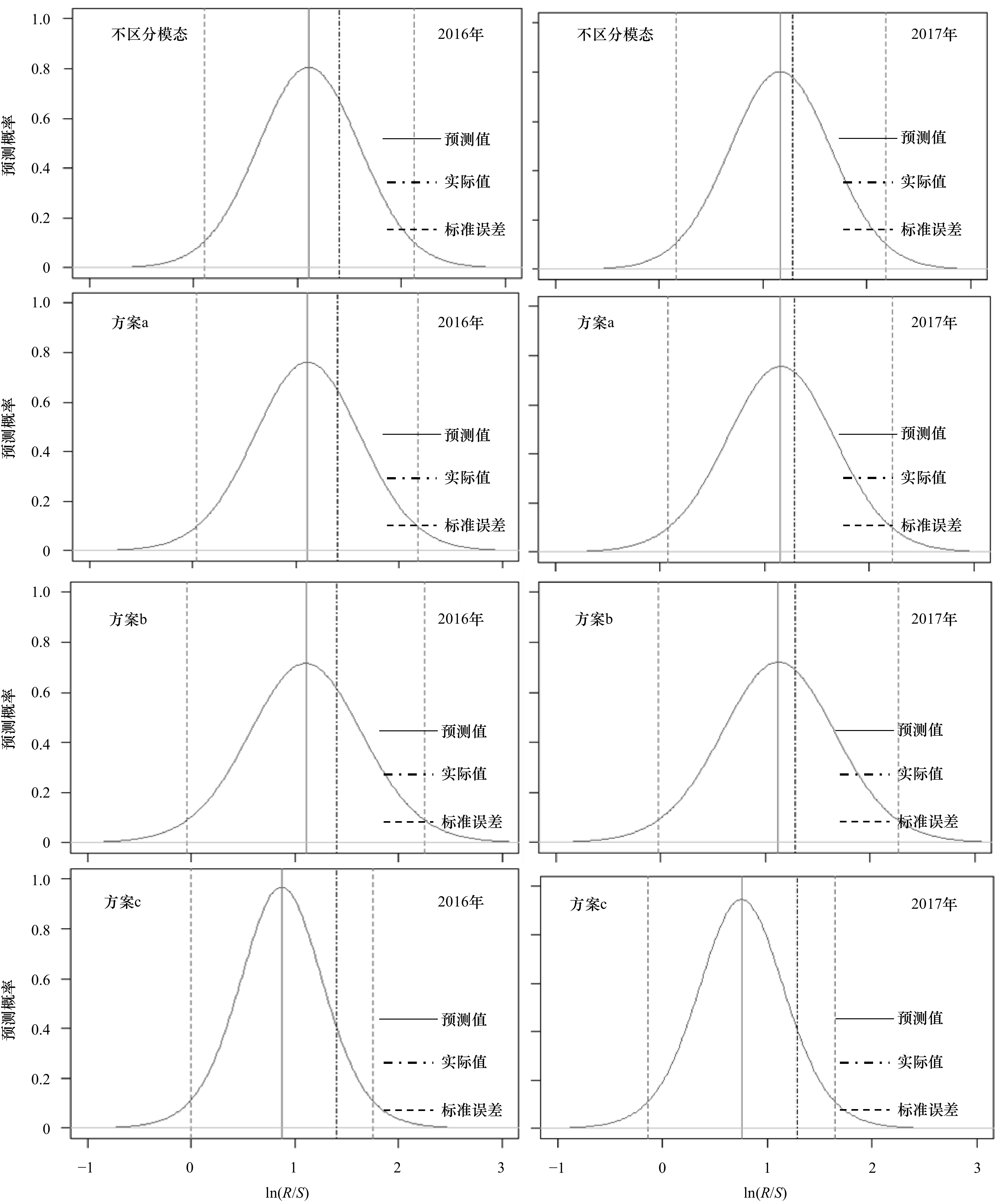Impact of climate change on recruitment of Trachurus murphyi based on different regimes
-
摘要: 智利竹筴鱼(Trachurus murphyi)是东南太平洋重要的经济鱼类之一,其资源量受补充量影响明显,了解补充量状况对智利竹筴鱼资源可持续利用和科学管理具有重要意义。本文基于模态分析将1971−2017年间智利竹筴鱼补充量划分不同模态,运用贝叶斯模型平均法,分析海表面温度、海表面盐度、海表面高度、厄尔尼诺和太平洋年代际振荡5个环境因子在不同模态中对补充量的解释能力,并探讨模态变动对补充量预测的影响。结果表明,第1模态(1971−1980年)更多的受捕捞因素的干扰;第2模态(1981−1990年)厄尔尼诺对补充量变动的解释概率最高;第3模态(1991−2001年)解释概率最高的环境因子为太平洋年代际振荡;第4模态(2002−2015年)厄尔尼诺为解释概率最高的环境因子。对比不考虑模态变动的分析结果,两者存在明显差异,基于不同模态的分析结果对智利竹筴鱼补充量变动的解释更为合理。研究认为,智利竹筴鱼补充量变动受到多个环境因子的影响,在不同模态时期起主导作用的环境因子也不同,推测年代际太平洋年代际振荡冷暖期交替与厄尔尼诺现象可能是诱发智利竹筴鱼补充量发生模态转变的重要因素。建议在未来智利竹筴鱼资源评估与管理中,应该考虑不同的模态变化及其影响因子。Abstract: Chilean jack mackerel (Trachurus murphyi) is one of the important economic fisheries in the Southeast Pacific Ocean. The stock abundance is inherently affected by recruitment. To find out the status of recruitment is of great significance to the sustainable yield and scientific management of resources. The recruitment of Chilean jack mackerel between 1971 and 2017 is divided into different regimes based on regime test. Then, the Bayesian model averaging is applied to the relationship between recruitment and five environmental factors (sea surface temperature, sea surface salinity, sea surface height, El Niño and Pacific decadal oscillation), and the impact of regime change in recruitment forecast is also discussed. The results show that the first regime (1971−1980) is more disturbed by fishing; in the second regime (1981−1990), El Niño has the highest probability of explaining for the change of recruitment; the environmental factor with the highest explanatory probability is Pacific Decadal Oscillation in the third regime (1991−2001); in the fourth regime (2002−2015), El Niño most likely explains the change in recruitment; comparing the analysis of regime shift and no regime shift models, there is a significant difference between the two. However, the results, with different regimes, are more reasonable to explain the change of recruitment. Recruitment abundance is affected by multiple environmental factors, but in different regimes, the dominant environmental factor changes. The regime shifts of recruitment are induced by the alternation of cold and warm periods of interdecadal Pacific decadal oscillation, and El Niño. It is suggested that different regime shift and their impact factors should be considered in the future assessment and management of Chilean jack mackerel resources.
-
Key words:
- Trachurus murphyi /
- Bayesian model averaging /
- regime shift /
- recruitment /
- Southeast Pacific Ocean
-
表 1 不同影响因子在不同模态阶段的PIP(%)
Tab. 1 PIP (%) of different impact factors on different regimes
影响因子 不分模态阶段 第1模态 第2模态 第3模态 第4模态 亲体量 99 34 86 100 98 SSH 76 41 26 23 32 SSS 20 46 27 24 22 SST 19 40 32 31 25 PDO 16 28 34 41 24 El Niño 14 24 49 23 33 表 2 基于BMA的PMP最高的前5个模型的后验概率(%)
Tab. 2 Posterior distribution (%) of top five models with highest PMP of all models from BMA for no shift model
影响因子 模型1 模型2 模型3 模型4 模型5 亲体量 √ √ √ √ √ SSS √ PDO √ SSH √ √ √ √ El Niño SST √ PMP(MCMC) 36% 9% 9% 9% 7% PMP(Exact) 36% 9% 9% 9% 7% 注:√表示该模型中包含的因子。 表 3 不同方案中基于BMA的PMP最高的前5个模型的后验概率(%)
Tab. 3 Posterior distribution (%) of top five models with highest PMP of all models from BMA for different program
模型 方案a 方案b 方案c 模型1 24 19 22 模型2 12 13 11 模型3 6 9 9 模型4 6 6 6 模型5 5 6 6 累计 52 51 53 -
[1] South Pacific Regional Fisheries Management Organisation. 7th Scientific Committee Meeting Report[R]. Cuba: SPRFMO, 2019. [2] Kuparinen A, Keith D M, Hutchings J A. Increased environmentally driven recruitment variability decreases resilience to fishing and increases uncertainty of recovery[J]. ICES Journal of Marine Science, 2014, 71(6): 1507−1514. doi: 10.1093/icesjms/fsu021 [3] 徐冰, 陈新军, 陆化杰, 等. 秘鲁外海茎柔鱼资源丰度和补充量与海表温度的相关关系[J]. 海洋渔业, 2013, 35(3): 296−302. doi: 10.3969/j.issn.1004-2490.2013.03.006Xu Bing, Chen Xinjun, Lu Huajie, et al. Relationship between sea surface temperature and abundance index, recruitment of Dosidicus gigas in the waters off Peru[J]. Marine Fisheries, 2013, 35(3): 296−302. doi: 10.3969/j.issn.1004-2490.2013.03.006 [4] Steele J H. Regime shifts in fisheries management[J]. Fisheries Research, 1996, 25(1): 19−23. doi: 10.1016/0165-7836(95)00440-8 [5] Beamish R J, Noakes D J, McFarlane G A, et al. The regime concept and natural trends in the production of Pacific salmon[J]. Canadian Journal of Fisheries and Aquatic Sciences, 1999, 56(3): 516−526. doi: 10.1139/f98-200 [6] Brodziak J, Legault C M. Model averaging to estimate rebuilding targets for overfished stocks[J]. Canadian Journal of Fisheries and Aquatic Sciences, 2005, 62(3): 544−562. doi: 10.1139/f04-199 [7] 王亮. 贝叶斯模型平均方法研究综述与展望[J]. 技术经济与管理研究, 2016(3): 19−23. doi: 10.3969/j.issn.1004-292X.2016.03.004Wang Liang. Overview and prospect of Bayesian model averaging[J]. Technoeconomics & Management Research, 2016(3): 19−23. doi: 10.3969/j.issn.1004-292X.2016.03.004 [8] South Pacific Regional Fisheries Management Organisation. 6th Scientific Committee Meeting Report[R]. Cuba: SPRFMO, 2018. [9] Hintzen N T, Corten A, Gerlotto F, et al. Hydrography and Jack Mackerel stock in the South Pacific[R]. Netherlands: IMARES, 2013. [10] Muck P, Castillo O S, Carrasco S. Abundance of sardine mackerel and horse mackerel eggs and larvae and their relationship to temperature, turbulence and anchoveta biomass off Peru. In the Peruvian anchoveta and its upwelling ecosystem: three decades of change[M]. Peru: ICLARM, 1990: 268−275. [11] Rodionov S, Overland J E. Application of a sequential regime shift detection method to the Bering Sea ecosystem[J]. ICES Journal of Marine Science, 2005, 62(3): 328−332. doi: 10.1016/j.icesjms.2005.01.013 [12] 袁兴伟, 刘尊雷, 程家骅, 等. 气候变化对冬季东海外海中下层游泳动物群落结构及重要经济种类的影响[J]. 生态学报, 2017, 37(8): 2796−2808.Yuan Xingwei, Liu Zunlei, Chen Jiahua, et al. Impact of climate change on nekton community structure and some commercial species in the offshore area of the northern East China Sea in winter[J]. Acta Ecologica Sinica, 2017, 37(8): 2796−2808. [13] 詹秉义. 渔业资源评估[M]. 北京: 中国农业出版社, 1995, 291−298.Zhan Bingyi. Fish Stock Assessment[M]. Beijing: China Agriculture Press, 1995: 291−298. [14] Amini S, Parmeter C F. Bayesian model averaging in R[J]. Journal of Economic and Social Measurement, 2011, 36(4): 253−287. doi: 10.3233/JEM-2011-0350 [15] Draper D. Assessment and propagation of model uncertainty[J]. Journal of the Royal Statistical Society: Series B (Methodological), 1995, 57(1): 45−70. doi: 10.1111/j.2517-6161.1995.tb02015.x [16] Stefan Z, Martin F. Bayesian model averaging employing fixed and flexible priors: The BMS package for R[J]. Journal of Statistical Software, 2015, 68(4): 1−37. [17] 刘尊雷, 袁兴伟, 杨林林, 等. 亲体量和环境对东海小黄鱼补充成功率的影响[J]. 应用生态学报, 2015, 26(2): 588−600.Liu Zunlei, Yuan Xingwei, Yang Linlin, et al. Effect of stock abundance and environmental factors on the recruitment success of small yellow croaker in the East China Sea[J]. Chinese Journal of Applied Ecology, 2015, 26(2): 588−600. [18] 张敏, 邹晓荣. 大洋性竹筴鱼渔业[M]. 北京: 中国农业出版社, 2011.Zhang Min, Zou Xiaorong. Oceanic Jack Mackerel Trachurus murphyi Fishery[M]. Beijing: China Agriculture Press, 2011. [19] Pineda J, Hare J A, Sponaugle S. Larval transport and dispersal in the coastal ocean and consequences for population connectivity[J]. Oceanography, 2007, 20(3): 22−39. doi: 10.5670/oceanog.2007.27 [20] Kasai A, Komatsu K, Sassa C, et al. Transport and survival processes of eggs and larvae of jack mackerel Trachurus japonicus in the East China Sea[J]. Fisheries Science, 2008, 74(1): 8−18. doi: 10.1111/j.1444-2906.2007.01491.x [21] Ianelli J N, Hollowed A B, Haynie A C, et al. Evaluating management strategies for eastern Bering Sea walleye pollock (Theragra chalcogramma) in a changing environment[J]. ICES Journal of Marine Science, 2011, 68(6): 1297−1304. doi: 10.1093/icesjms/fsr010 [22] South Pacific Regional Fisheries Management Organization. Report of the science working group[R]. Cuba: SPRFMO, 2011. [23] 张畅, 陈新军. 海洋环境因子对澳洲鲐亲体补充量关系的影响—基于贝叶斯模型平均法的研究[J]. 海洋学报, 2019, 41(2): 99−106.Zhang Chang, Chen Xinjun. The impact of environmental factors on stock-recruitment relationship of spotted mackerel—Based on Bayesian model averaging method[J]. Haiyang Xuebao, 2019, 41(2): 99−106. [24] Li Gang, Zou Xiaorong, Chen Xinjun, et al. Standardization of CPUE for Chilean jack mackerel (Trachurus murphyi) from Chinese trawl fleets in the high seas of the Southeast Pacific Ocean[J]. Journal of Ocean University of China, 2013, 12(3): 441−451. doi: 10.1007/s11802-013-1987-1 [25] 常永波. 几种人工神经网络模型在智利竹筴鱼渔场渔情预报中的比较研究[D]. 上海: 上海海洋大学, 2016.Chang Yongbo. Fishery forecasting comparative study of Trachurus murphyi in the southeast pacific fishing grounds based on artificial neural network model[D]. Shanghai: Shanghai Ocean University, 2016. [26] Haltuch M A, Punt A E, Dorn M W. Evaluating the estimation of fishery management reference points in a variable environment[J]. Fisheries Research, 2009, 100(1): 42−56. doi: 10.1016/j.fishres.2009.03.001 [27] Blanco J L, Thomas A C, Carr M E, et al. Seasonal climatology of hydrographic conditions in the upwelling region off northern Chile[J]. Journal of Geophysical Research: Oceans, 2001, 106(C6): 11451−11467. doi: 10.1029/2000JC000540 [28] Arcos D F, Cubillos L A, Núñez S P. The jack mackerel fishery and El Niño 1997–98 effects off Chile[J]. Progress in Oceanography, 2001, 49(1/4): 597−617. doi: 10.1016/S0079-6611(01)00043-X [29] 张敏, 邹晓荣, 季星辉, 等. 东南太平洋公海水域智利竹筴鱼探捕及其商业开发前景探讨[J]. 水产学报, 2005, 29(3): 386−391.Zhang Min, Zou Xiaorong, Ji Xinghui, et al. Discussion on exploratory fishing of Chilean jack mackerel (Trachurus murphyi) in the open sea of the southeast Pacific and prospect of its commercial exploitation[J]. Journal of Fisheries of China, 2005, 29(3): 386−391. [30] 吕俊梅, 琚建华, 张庆云, 等. 太平洋年代际振荡冷、暖背景下ENSO循环的特征[J]. 气候与环境研究, 2005, 10(2): 238−249. doi: 10.3878/j.issn.1006-9585.2005.02.11Lü Junmei, Ju Jianhua, Zhang Qingyun, et al. The characteristics of ENSO cycle in different phases of Pacific decadal oscillation[J]. Climatic and Environmental Research, 2005, 10(2): 238−249. doi: 10.3878/j.issn.1006-9585.2005.02.11 [31] 杨修群, 朱益民, 谢倩, 等. 太平洋年代际振荡的研究进展[J]. 大气科学, 2004, 28(6): 979−992. doi: 10.3878/j.issn.1006-9895.2004.06.15Yang Xiuqun, Zhu Yimin, Xie Qian, et al. Advances in studies of Pacific decadal oscillation[J]. Chinese Journal of Atmospheric Sciences, 2004, 28(6): 979−992. doi: 10.3878/j.issn.1006-9895.2004.06.15 [32] Mantua N J, Hare S R. The Pacific decadal oscillation[J]. Journal of Oceanography, 2002, 58(1): 35−44. doi: 10.1023/A:1015820616384 [33] Zwolinski J P, Demer D A. Environmental and parental control of Pacific sardine (Sardinops sagax) recruitment[J]. Ices Journal of Marine Science, 2014, 71(8): 2198−2207. doi: 10.1093/icesjms/fst173 [34] Dioses T. Abundance and distribution patterns of Jack mackerel Trachurus murphyi in Peru[J]. Revista Peruana de Biologia, 2013, 20(1): 67−74. [35] Yu Wei, Wen Jian, Chen Xinjun, et al. Trans-Pacific multidecadal changes of habitat patterns of two squid species[J]. Fisheries Research, 2021, 233: 105762. doi: 10.1016/j.fishres.2020.105762 [36] Espino M. The Jack mackerel Trachurus murphyi and the environmental macro-scale variables[J]. Revista Peruana De Biología, 2013, 20(1): 9−20. [37] Wang Chunzai, Fiedler P C. ENSO variability and the eastern tropical Pacific: A review[J]. Progress in Oceanography, 2006, 69(2/4): 239−266. [38] Lorenzo E D, Ohman M D. A double-integration hypothesis to explain ocean ecosystem response to climate forcing[J]. Proceedings of the National Academy of Sciences of the United States of America, 2013, 110(7): 2496−2499. doi: 10.1073/pnas.1218022110 [39] Chaigneau A, Gizolme A, Grados C. Mesoscale eddies off Peru in altimeter records: Identification algorithms and eddy spatio-temporal patterns[J]. Progress in Oceanography, 2008, 79(2/4): 106−119. [40] Wang Xin, Du Yunyan, Zhou Chenghu, et al. An improved, SSH-based method to automatically identify mesoscale eddies in the ocean[J]. Journal of Tropical Oceanography, 2013, 32(2): 15−23. [41] Correa-Ramirez M A, Hormazábal S, Yuras G. Mesoscale eddies and high chlorophyll concentrations off central Chile (29°–39°S)[J]. Geophysical Research Letters, 2007, 34(12): L12604. doi: 10.1029/2007GL029541 [42] Govoni J J, Hare J A, Davenport E D, et al. Mesoscale, cyclonic eddies as larval fish habitat along the southeast United States shelf: a Lagrangian description of the zooplankton community[J]. ICES Journal of Marine Science, 2010, 67(3): 403−411. doi: 10.1093/icesjms/fsp269 [43] Morales C E, Torreblanca M L, Hormazabal S, et al. Mesoscale structure of copepod assemblages in the coastal transition zone and oceanic waters off central-southern Chile[J]. Progress in Oceanography, 2010, 84(3/4): 158−173. [44] Parada C, Núñez S, Correa M, et al. Advances in biophysical modeling of Chilean jack mackerel in the South Pacific[J]. ICES CM, 2010, 20: 32. [45] Parada C, Mullon C, Roy C, et al. Does vertical migratory behaviour retain fish larvae onshore in upwelling ecosystems? A modelling study of anchovy in the southern Benguela[J]. African Journal of Marine Science, 2008, 30(3): 437−452. doi: 10.2989/AJMS.2008.30.3.1.635 [46] Serra R. Important life history aspects of the Chilean jack mackerel, Trachurus symmetricus murphyi[J]. Investigacion Pesquera (Chile), 1991, 36: 67−83. [47] 陈春光. 东南太平洋智利竹筴鱼渔场空间分布及其栖息地适宜性指数的研究[D]. 上海: 上海海洋大学, 2015.Chen Chunguang. Study on fishing ground spatial distribution and habitat suitability index (HSI) model of Chilean Jack Mackerel (Trachurus murphyi) in the Southeast Pacific Ocean[D]. Shanghai: Shanghai Ocean University, 2015. [48] Rodionov S N. A sequential algorithm for testing climate regime shifts[J]. Geophysical Research Letters, 2004, 31(9): L09204. [49] Wayte S E. Management implications of including a climate-induced recruitment shift in the stock assessment for jackass morwong (Nemadactylus macropterus) in south-eastern Australia[J]. Fisheries Research, 2013, 142: 47−55. doi: 10.1016/j.fishres.2012.07.009 -





 下载:
下载:





